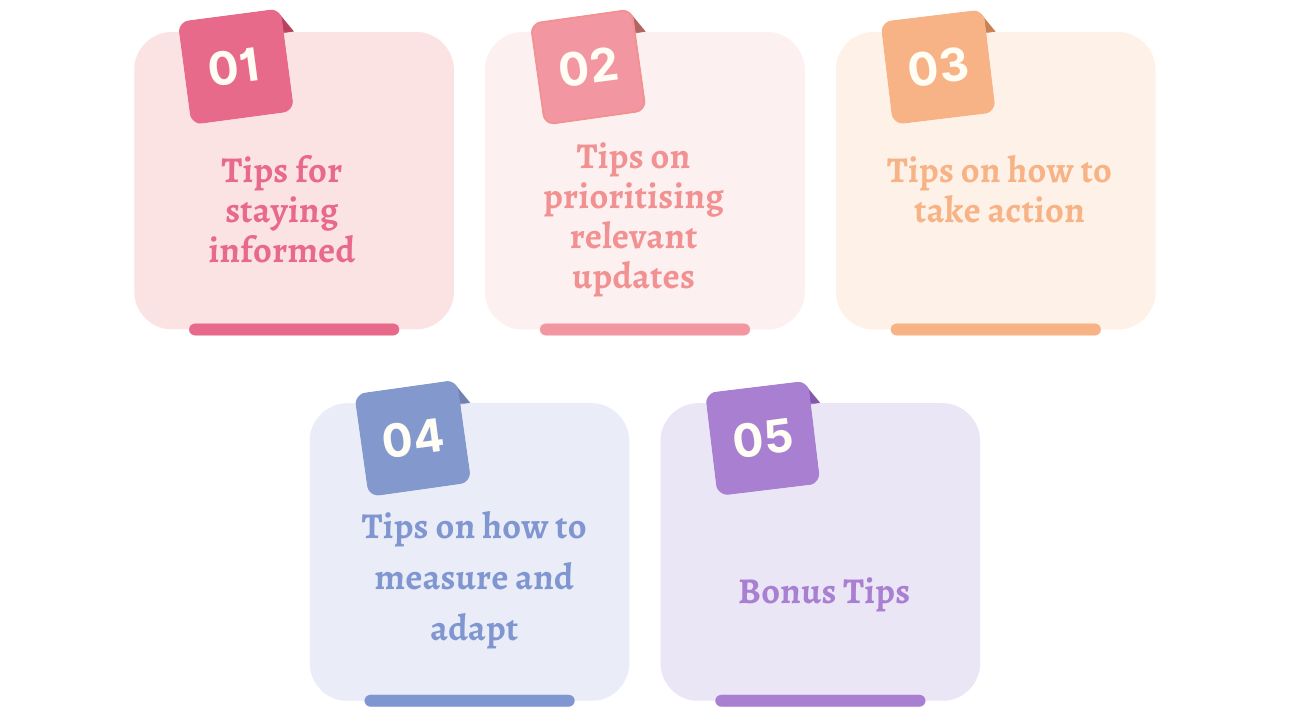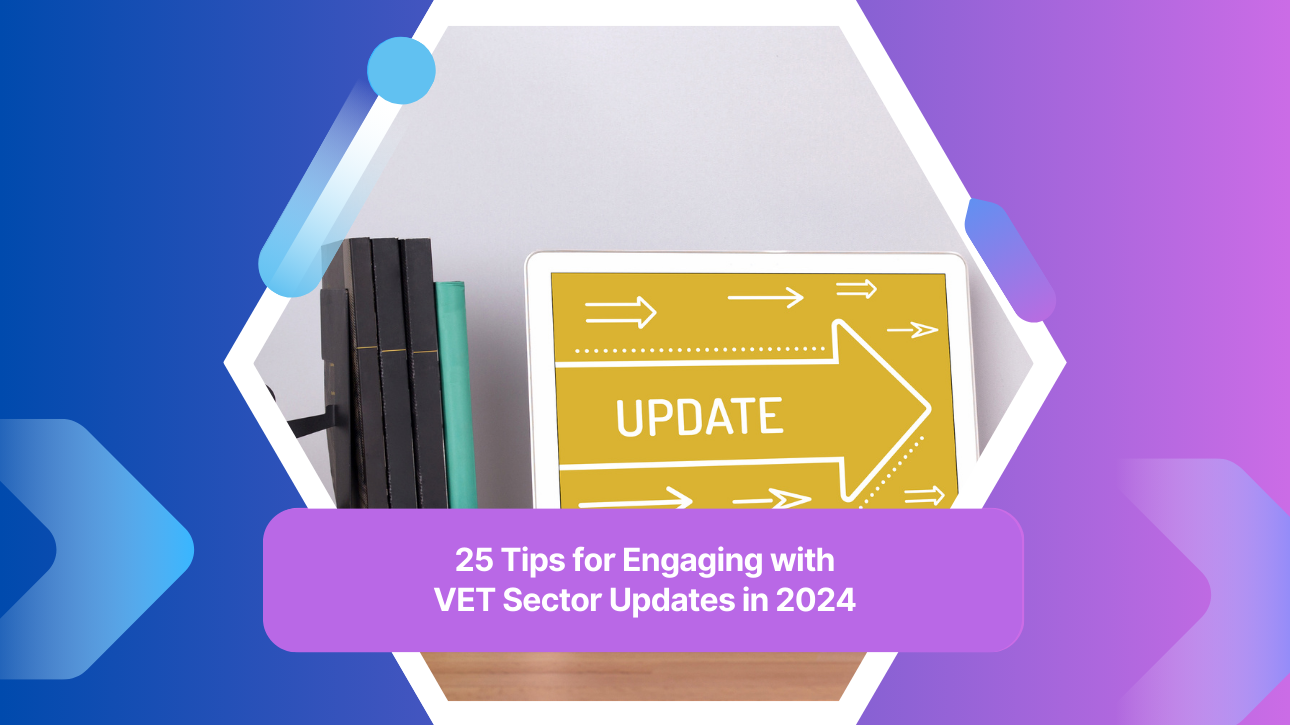The world of work is in constant flux. New technologies emerge, industries evolve, and the skills needed to thrive are constantly shifting. In this dynamic landscape, staying informed about Vocational Education and Training (VET) sector updates is no longer optional – it’s essential.
For registered training organisations, engaging with VET updates translates to a multitude of long-term benefits: attracting top talent, optimising training programs, boosting employee productivity, and ensuring your workforce possesses the skills to navigate future career. But with a constant stream of information, where do you even begin?
This blog is your roadmap to navigating the maze of VET updates in 2024. We’ll equip you with 25 practical tips to stay informed, prioritise relevant changes, take action, and measure the impact on your RTO.
Whether you’re a seasoned RTO professional or just starting to explore the Australian VET sector, you’ll find valuable insights and actionable steps. We’ll cover everything from identifying key industry trends to collaborating with VET providers and measuring the success of your initiatives.
So, buckle up and get ready to embrace the future of work! By engaging with VET updates, you’ll not only stay ahead of the curve but also invest in the skills and knowledge that will propel your RTO to success. Let’s dive in!

The tips are divided into 5 segments, namely:
- Tips for staying informed.
- Tips on prioritising relevant updates.
- Tips on how to take action.
- Tips on how to measure and adapt.
- Bonus Tips.
Stay Informed
Tip 1:
Subscribe to industry publications, government websites, and professional association newsletters for updates. Get notified directly about new policies, funding opportunities, and industry trends.
Tip 2:
Follow relevant social media groups, hashtags, and influencers for real-time news and discussions. Tap into real-time discussions, debates, and emerging trends shaping the VET sector.
Tip 3:
Attend industry events, conferences, and webinars to learn about emerging trends and best practices. Network with experts, gain insights into best practices and stay ahead of the innovation curve.
Tip 4:
Participate in VET-focused online communities and forums to connect with peers and share knowledge. Connect with peers, share knowledge, and learn from diverse perspectives.
Tip 5:
Encourage employees to engage with VET updates by offering subscriptions, attendance stipends, or internal knowledge-sharing sessions. This will foster a culture of continuous learning for your RTO.
Prioritise Relevant Updates
Tip 6:
Identify your company’s specific needs and challenges related to VET (e.g., talent acquisition, upskilling, compliance). Identify your company’s specific needs and challenges.
Tip 7:
Filter updates based on their relevance to your industry, target workforce, and specific programs.
Tip 8:
Utilise keyword alerts and RSS feeds to stay informed about updates related to your chosen keywords.
Tip 9:
Leverage data analytics tools to identify trends and patterns in VET updates that impact your RTO. It will improve your vocational training and assessment while providing quality outcomes and employment opportunities for your students.
Tip 10:
Assign a dedicated team member or department to monitor and curate VET updates for your organisation. This will help you never miss out on VET updates and will help you in quick decision-making.
Take Action
Tip 11:
Evaluate the potential impact of each update on your training programs, recruitment strategies, current industry engagement and workforce development initiatives. Analyse how each update affects your training programs, recruitment strategies, and current industry engagement.
Tip 12:
Collaborate with other VET providers and industry stakeholders to develop customised training programs aligned with industry needs and updated standards. Develop customised training programs that align with industry needs and updated standards.
Tip 13:
Offer mentorship or internship opportunities to VET students to gain insights into future workforce skills. Gain insights into future workforce skills by engaging with VET students.
Tip 14:
Participate in industry working groups or advisory boards to shape the future of VET and influence policy changes. This will help you curate an innovative approach for your RTO.
Tip 15:
Share your expertise and best practices by contributing to industry engagement activities, and industry publications, speaking at events, or partnering with VET institutions.
Measure and Adapt
Tip 16:
Track the impact of your engagement with VET updates on key metrics like employee retention, productivity, and innovation.
Tip 17:
Regularly review and adjust your approach and engagement plan based on the effectiveness of your chosen strategies and the evolving VET landscape.
Tip 18:
Conduct surveys or focus groups to gather feedback from employees and stakeholders on their needs and preferences regarding VET policy and updates.
Tip 19:
Stay open to new technologies and tools that can streamline your process of engaging with and implementing VET updates.
Tip 20:
Invest in continuous learning for your team to ensure they possess the skills and knowledge to effectively engage with VET updates.
Bonus Tips
Tip 21:
Encourage a culture of lifelong learning within your organisation by promoting VET qualifications and opportunities.
Tip 22:
Partner with local VET institutions to offer job training, scholarships or work-based learning programs for your employees. This partnership will offer additional support for your RTO.
Tip 23:
Advocate for policies that support quality VET reform and increased access to training programs.
Tip 24:
Share your success stories and best practices with other businesses to inspire broader engagement with VET updates.
Tip 25:
Remember, engaging with VET updates is an ongoing process, so stay committed and adaptable to continuous improvement.

Conclusion
This journey through VET sector updates is just the beginning. The world of work is a dynamic landscape, and staying informed is an ongoing commitment. As training providers, we have a unique opportunity to improve VET by embracing a culture of lifelong learning, both within our organisations and for our learners. Encourage your employees to pursue VET opportunities, participate in industry discussions, and actively contribute to shaping the future of the sector.
By following the tips outlined in this blog, you can become a magnet for top talent, equipped with the high-quality skills needed to thrive in the face of change. Remember, engaging with VET updates is not just about compliance; it’s about investing in your future success and contributing to the overall economic development of Australia.
Let’s work together, key stakeholders including training providers, regulatory bodies, and the Australian government, to foster a high-quality, responsive VET system. By actively engaging in VET reviews, proposing potential solutions, and collaborating with industry partners, we can ensure Australia’s vocational training remains relevant, effective, and prepares our workforce for the opportunities and challenges of tomorrow.
Remember, work experience, skills development, and regulatory approaches are constantly evolving. Stay informed, stay engaged, and let’s build a stronger VET workforce together.
Ready to take action?
Then VET Resources can be your best partner. We offer the best and the highest quality RTO training resources. For more information on free samples and free demos contact us here.
Frequently Asked Questions
Where can I find reliable sources for VET updates?
Start with the official government websites for education and training departments in your region. Many industry associations and professional bodies also offer newsletters, publications, and events focused on VET updates. You can also leverage online resources like RSS feeds, keyword alerts, and social media groups to stay informed about relevant news and discussions.
How can I prioritise which updates are most relevant to my business?
Conduct a needs assessment to identify your company’s specific challenges and goals related to talent acquisition, training, and workforce development. Then, filter VET updates based on their alignment with your industry, target workforce, and the specific programs you offer. Utilise data analytics tools to identify trends and patterns in updates that have a direct impact on your business.
What are some concrete steps I can take to engage with VET updates?
- Collaborate with VET providers to develop customised training programs aligned with industry needs and updated standards.
- Offer mentorship or internship opportunities to VET students to gain insights into future workforce skills.
- Participate in industry working groups or advisory boards to shape the future of VET and influence policy changes.
- Share your expertise and best practices by contributing to industry publications, speaking at events, or partnering with VET institutions.
How can VET updates benefit my vocational education training (VET) provider?
By staying informed about changes in training packages, industry skills, and regulatory frameworks, you can ensure your programs are relevant, high-quality, and aligned with current labour market needs. This attracts quality students, strengthens your employer engagement, and positions you as a leader in strengthening VET.
How can I identify the most relevant VET updates for my students?
Focus on updates within your specific industry sectors and related to the career pathways offered by your programs. Utilise resources like the Australian Skills Quality Authority (ASQA) website and industry engagement plans to identify key skills and quality issues addressed in recent updates.
How can I ensure my training aligns with regulatory requirements?
The risk-based model by Labour Force Australia empowers providers to tailor their compliance approach based on risk. Utilise the ASQA website and resources like the VET Framework to stay informed about regulatory changes and implement necessary adjustments.
What resources can help me find professional development opportunities for my staff?
Many quality providers offer professional development programs aligned with current VET updates. Look for training focused on areas like assessment methods, recognition of prior learning, and current industry skills. Industry associations and government agencies also offer valuable resources and workshops.
How can I help individual students benefit from VET updates?
Provide career advice that integrates updated labour market information and industry trends. Encourage them to explore VET pathways aligned with their interests and future aspirations. Utilize recognition of prior learning mechanisms to acknowledge existing skills and personalise their learning journey.
What steps can I take to strengthen my engagement with employers?
Develop collaborative industry engagement plans that address workforce needs and skills gaps. Partner with employers to offer work experience placements and traineeships. Regularly seek feedback on your programs and curriculum to ensure they align with evolving industry skills demands.
How can I contribute to strengthening VET in Australia?
Stay informed about government initiatives like the Strengthening Skills review and actively participate in consultations. Share your expertise and best practices with quality providers and professional networks. Advocate for policies that support access to relevant training and promote the value of VET to the broader Australian economy.
Disclaimer:
The information presented on the VET Resources blog is for general guidance only. While we strive for accuracy, we cannot guarantee the completeness or timeliness of the information. VET Resources is not responsible for any errors or omissions, or for the results obtained from the use of this information. Always consult a professional for advice tailored to your circumstances.






